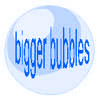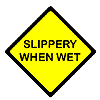|
CASEY CARLE'S "SECRET" BUBBLE SOLUTIONS
I do not share the exact formulations for what I use in my popular stage show. But I can make suggestions for some excellent home-made solutions that will make you appear to be a bubble wizard in no time flat! (er, I mean "round"!). The following information is accurate BUT environmental conditions (humidity, dust, wind etc.) will affect the life span of a bubble more than the mix. Be sure to read ALL the helpful clues below to get the best bubbling experience possible. Keep in mind: a solution that works well for small artistic sculptures may actually be too "heavy" to work well for bigger bubbles.
Note: My stage show uses a "professional line" detergent that is a challenge to find and so it is not part of my suggestions below.
Try these:
|
WHAT YOU WILL NEED
DISTILLED WATER
Available by the gallon at most pharmacies and supermarkets.
DETERGENT:
Ultra/Concentrated "Dawn Complete" aka "Dawn Hand Renewal"
(see below for other
choices)*
GLYCERIN
An ointment usually found in the skin care section of most pharmacies
A CLEAN Mixing Bucket
Measuring Cup
1 Tablespoon measure
Large Plastic Stirring Spoon
FOR GIANT BUBBLES YOU WILL NEED:
A pre-made quality commercial mix
|
|
|
|
 Bubble Formula #1
Bubble Formula #1
For general blowing and popping fun
MAKE IT AT HOME:
Step 1
Into your Mixing bucket add an entire gallon of lukewarm Distilled Water.
Step 2
Stirring SLOWLY so as not to make lather, add in 10 oz. of Detergent (important: discard any excess foam).
Step 3
Stir in 6 Tablespoons (2 oz) of Glycerin
 Bubble Formula #2
Bubble Formula #2
For more successful bigger bubbles
MAKE IT AT HOME:
Same as Formula #1 only add 40-60 ounces of a pre-made quality commercial mix.
 Bubble Formula #3
Bubble Formula #3
For longer lasting small sculptures; probably too 'heavy' for big bubbles
MAKE IT AT HOME:
Same as #2 (using pre-made quality commercial mix only add 2 ounces more Detergent and 1 more Tablespoons Glycerin
|
Important Notes:
- The more expensive dish soaps tend to work better. See notes in "What You’ll Need" above.
- Distilled water is consistent and therefore the best to suggest. Tap water may be OK to use but only if it is “soft water”. Do not use “hard water”.
- Glycerin [GLISS-er-inn] helps slow down the evaporation of water. Glycerin is not required on days of high humidity (50% or higher) because evaporation is slowed down naturally when the air if already full of moisture. It is safe to use but too much can make the mix too heavy.
- Mix your solution well BUT if planning to use it soon avoid making a lot of foam. I strongly suggest very warm water for mixing. Store in a clean, sealed container.
- Only pour the amount you need and keep the rest covered so evaporation doesn't thicken your solution. It can be helpful but not necessary to let it sit 24 hours before using it.
- Do not store it below 60 degrees for long periods.
"When" and "Where" to bubble
 HUMIDITY IS THE KEY. Even ordinary solutions will perform better in high humidity. Temperature is less important than humidity, but cold air tends to be less humid than warm air.
HUMIDITY IS THE KEY. Even ordinary solutions will perform better in high humidity. Temperature is less important than humidity, but cold air tends to be less humid than warm air.
Great Conditions: Humidity 60% and higher. After a rain shower. Foggy days. Wet, sticky, muggy days. Early morning with dew on the grass.
Good Conditions: Humidity 30%-60%. Cloudy days. Shaded places. At dusk as the sun sets or at dawn when it’s rising. (The colors are deeper when the sun’s rays are at a low angle and diffused)
Fun Conditions: Near a warm house on a cool day - bubbles will rise with the warmer air and appear to sail up and over the house! Below 10 degrees Fahrenheit - to freeze the little ones! Slightly breezy conditions to break big bubbles up into smaller ones (only works with a very good mix). Near a pond, stream or just a big puddle to float bubbles! (Be environmentally friendly: limit the amount of bubbles onto the water and avoid spills into the water or soil).
Avoid: Contaminating the mix with grass, dirt, sand, sunscreen, food & drinks. Humidity less than 30%. Direct sunlight. Dusty air. Strong breezes that burst all big bubbles. Foamy build-up (skim it off). Non-detergent soaps such as bar soap - the wrong soaps will ruin your mix! Children and pets who want to pop every bubble you make! (Hint #1: make a few small ones for them to chase while you focus on the big ones! Hint #2: teach kids how to keep a bubble aloft with the movement of their hands, to try and blow a bubble inside a bubble, or catch one on a wet hand. Hey! Bubbles are NOT just for popping anymore!)


Remember: Soap solution will sting your eyes. Soap solution is very slippery - avoid areas that might still be slippery long after you are gone. Never make bubbles near moving traffic. Soap solution can damage grass - dilute with water when finished.
HAVE FUN!!
BACK to Bubble-FAQs Main Page
|
Home |
Who is he? |
Entertainment |
Science Programs |
Corporate & Adult Events |
Consulting |
|
Appearances |
FAQs & Formulas |
News |
Booking Info |
Photos |
Video |
Credits |
|
Send Email |

| 



 Whois Casey Carle?
Whois Casey Carle?
 Bubble Formula #1
Bubble Formula #1 Bubble Formula #2
Bubble Formula #2 Bubble Formula #3
Bubble Formula #3